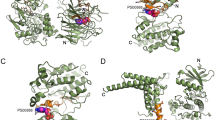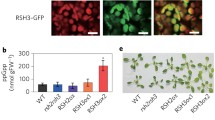Abstract
Nucleoside diphosphate kinase (NDPK) is involved in the regeneration of nucleoside triphosphates (NTPs) through its phosphotransferase activity via an autophosphorylating histidine residue. Additionally, autophosphorylation of serine and/or threonine residues is documented for NDPKs from various organisms. However, the metabolic significance of serine/threonine phosphorylation has not been well characterized. In this study we report the cloning and characterization of NDPKI from cultured sugarcane (Saccharum officinarum L. line H50-7209) cells, and modulation of serine autophosphorylation of NDPK1 in response to heat-shock (HS). Heat-shock treatment at 40°C for 2 h resulted in a 40% reduction in labeled phosphoserine in NDPK1. This dephosphorylation was accompanied by an increase in NDPK enzyme activity. In contrast, NDPK1 in cultured tobacco (cv. W-38) cells did not show changes in autophosphorylation or increased enzyme activity in response to HS. The mRNA or protein level of NDPK1 did not increase in response to HS. Sugarcane cells sustain the constitutive protein synthesis in addition to heat-shock protein synthesis during HS, while constitutive protein synthesis is significantly reduced in tobacco cells during HS. Thus, HS modulation of NDPK1 activity and serine dephosphorylation in sugarcane cells may represent an important physiological role in maintaining cellular metabolic functions during heat stress.






Similar content being viewed by others
Abbreviations
- NDP:
-
Nucleoside diphosphate
- HS:
-
Heat shock
- HSP:
-
Heat-shock protein
- HSR:
-
Heat shock response
References
Ahsan N, Lee DG, Lee KW, Alam I, Lee SH, Bahk JD, Lee BH (2008) Glyphosate-induced oxidative stress in rice leaves revealed by proteomic approach. Plant Physiol Biochem 46:1062–1070
Choi G, Yi H, Lee J, Kwon YK, Soh MS, Shin B, Luka Z, Hahn TR, Song PS (1999) Phytochrome signaling is mediated through nucleoside diphosphate kinase 2. Nature 401:610–613
Choi G, Kim JI, Hong SW, Shin B, Choi G, Blakeslee JJ, Murphy AS, Seo YW, Kim K, Koh EJ, Song PS, Lee H (2005) A possible role for NDPK2 in the regulation of auxin-mediated responses for plant growth and development. Plant Cell Physiol 46:1246–1254
Cooper P, Ho TH (1983) Heat shock proteins in maize. Plant Physiol 71:215–222
Crow DS, Beyer EC, Paul DL, Kobe SS, Lau AF (1990) Phosphorylation of connexin43 gap junction protein in uninfected and Rous sarcoma virus-transformed mammalian fibroblasts. Mol Cell Biol 10:1754–1763
Dorion S, Dumas F, Rivoal J (2006) Autophosphorylation of Solanum chacoense cytosolic nucleoside diphosphate kinase on ser117. J Exp Bot 57:4079–4788
Engel M, Seifert M, Theisinger B, Seyfert U, Welter C (1998) Glyceraldehyde-3-phosphate dehydrogenase and Nm23-H1/nucleoside diphosphate kinase A. Two old enzymes combine for the novel Nm23 protein phosphotransferase function. J Biol Chem 273:20058–20065
Fukamatsu Y, Yabe N, Hasunuma K (2003) Arabidopsis NDK1 is a component of ROS signaling by interacting with three catalases. Plant Cell Physiol 44:982–989
Galvis MLE, Marttila S, Hakansson G, Forsberg J, Knorpp C (2001) Heat stress response in pea involves interaction of motochondrial nucleoside diphosphate kinase with a novel 86-kilodalton protein. Plant Physiol 126:69–77
Genoud T, Santa Cruz MT, Kulisic T, Sparla F, Frankhauser C, Metraux J-P (2008) The protein phosphatase 7 regulates phytochrome signaling in Arabidopsis. PLoS One 3(7):e2699
Gilles AM, Prescan E, Vonica A, Lascu I (1991) Nucleoside diphosphate kinase from human erythrocytes. J Biol Chem 266:8784–8789
Harrington HM, Alm DM (1988) Interaction of heat and salt tolerance in cultured tobacco cells. Plant Physiol 88:618–625
Harris N, Taylor JE, Roberts JA (1994) Isolation of a mRNA encoding a nucleoside diphosphate kinase from tomato that is up-regulated by wounding. Plant Mol Biol 25:739–742
Hasunama K, Yabe N, Yoshida Y, Ogura Y, Hamada T (2003) Putative functions of nucleoside diphosphate kinase in plants and fungi. J Bioenerg Biomembr 35:57–65
Hemmerich S, Pecht I (1992) Oligomeric structure and autophosphorylation of nucleoside diphosphate kinase from rat mucosal mast cells. Biochemistry 31:4580–4587
Hippe A-J, Lutz S, Cuello F, Knorr K, Vogt A, Jakobs KH, Wieland T, Niroomand F (2003) Activation of heterotrimeric G proteins by a high energy phosphate transfer via nucleoside diphosphate kinase (NDPK) B and Gβ subunits. J Biol Chem 278:7227–7233
Hurkman WJ, Tanaka CK (1987) The effects of salt on the pattern of protein synthesis in barley roots. Plant Physiol 83:517–524
Kanabus J, Pikaard CS, Cherry JH (1984) Heat shock proteins of tobacco cell suspension cultures during growth cycle. Plant Physiol 75:639–644
Kavanaugh-Black A, Connolly DM, Chugani SA, Chakrabarty AM (1994) Characterization of nucleoside diphosphate kinase from Pseudomonas aeruginosa: complex formation with succinyl–CoA synthetase. Proc Natl Acad Sci USA 91:5883–5887
Lee B, Yoshida Y, Hasunuma K (2009) Nucleoside diphosphate kinase-1 regulates hyphal development via the transcriptional regulation of catalase in Neurospora crassa. FEBS Lett 583:3291–3295
Lowry OH, Rosenborough NJ, Farr AL, Randall RJ (1951) Protein measurement with the Folin phenol reagent. J Biol Chem 193:256–275
MacDonald NJ, De La Rosa A, Benedict MA, Freije JMP, Krutsch H, Steeg PS (1993) A serine phosphorylation of Nm23, and not its nucleoside diphosphate kinase activity, correlates with suppression of tumor metastatic potential. J Biol Chem 268:25780–25788
McGookin R (1984) RNA extraction by the guanidine thiocyanate procedure. In: Walker JA (ed) Methods in molecular biology. Humana Press, Clifton, pp 113–116
Mehta A, Orchard S (2009) Nucleoside diphosphate kinase (NDPK, NM23, AWD): recent regulatory advances in endocytosis, metastasis, psoriasis, insulin release, fetal erythroid lineage and heart failure; translational medicine exemplified. Mol Cell Biochem 329:3–15
Moisyadi S, Harrington HM (1989) Characterization of the heat shock response in cultured sugarcane cells. I. Physiology of the heat shock response and heat shock protein synthesis. Plant Physiol 90:1156–1162
Moisyadi S, Dharmasiri S, Harrington HM, Lukas TJ (1994) Characterization of a low molecular mass autophosphorylating protein in cultured sugarcane cells and its identification as a nucleoside diphosphate kinase. Plant Physiol 104:1401–1409
Moon H, Lee B, Choi G, Shin D, Prasad DT, Lee O, Kwak S-S, Kim DH, Nam J, Bahk J, Hong JC, Lee SY, Cho MJ, Lim CO, Yun D-J (2003) NDPK 2 interacts with two oxidative stress-activated MAPKs to regulate cellular redox state and enhances multiple stress tolerance in transgenic plants. PNAS 100:359–363
Morera S, Chaidmi M, LeBras G, Lascu I, Janin J (1995) Mechanism of phosphate transfer by nucleoside diphosphate kinase: X-ray structure of the phosphohistidine intermediate of the enzymes from Drosophila and Dictyostelium. Biochemistry 34:11062–11070
Mukhopadhyay S, Shankar S, Walden W, Chakrabarty AM (1997) Complex formation of the elongation factor Tu from Pseudomonas aeruginosa with nucleoside diphoshate kinase modulates ribosomal GTP synthesis and peptide chain elongation. J Biol Chem 272:17815–17820
Munoz-Dorado J, Almaula N, Inouye S, Inouye M (1993) Autophosphorylation of nucleoside diphosphate kinase from Myxococcus xanthus. J Bact 175:1176–1181
Nomura T, Yatsunami K, Honda A, Sugimoto Y, Fukui T, Zhang J, Yamamoto J, Ichikawa A (1992) The amino acid sequence of nucleoside diphosphate kinase I from spinach leaves, as deduced from the cDNA sequence. Arch Biochem Biophys 297:42–45
Pan L, Kawai M, Yano A, Uchiyama H (2000) Nucleoside diphosphate kinase required for coleoptile elongation in rice. Plant Physiol 122:447–452
Parks RE Jr, Agarwal RP (1973) Nucleoside diphosphokinases. In: Boyer PD (ed) The enzymes, vol 8. Academic Press, New York, pp 307–333
Shen Y, Han YJ, Kim JI, Song PS (2008) Arabidopsis nucleoside diphosphate kinase-2 as a plant GTPase activating protein. BMB Rep 41:645–650
Thakur RK, Kumar P, Halder K, Verma A, Kar A, Parent JL, Basundra R, Kumar A, Chowdhury S (2009) Metastases suppressor NM23–H2 interaction with G-quadruplex DNA within c-MYC promoter nuclease hypersensitive element induces c-MYC expression. Nucleic Acids Res 37:172–183
Wieland T (2007) Interaction of nucleoside diphosphate kinase B with heterotrimeric G protein betagamma dimmers, consequences on G protein activation and stability. Naunyn Schmiedebergs Arch Pharmacol 374:373–383
Acknowledgments
The authors wish to thank Dr. Alan F. Lau for phosphoamino acid analyses. This research was supported by the U.S. Department of Agriculture under NRI award #95-37100-2025 (to HMH) and Texas State University REP Grant (to ND and SD).
Author information
Authors and Affiliations
Corresponding author
Additional information
Communicated by Y. Lu.
Rights and permissions
About this article
Cite this article
Dharmasiri, S., Harrington, H.M. & Dharmasiri, N. Heat shock modulates phosphorylation status and activity of nucleoside diphosphate kinase in cultured sugarcane cells. Plant Cell Rep 29, 1305–1314 (2010). https://doi.org/10.1007/s00299-010-0917-6
Received:
Revised:
Accepted:
Published:
Issue Date:
DOI: https://doi.org/10.1007/s00299-010-0917-6




